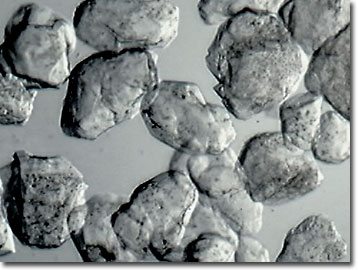Oblique Digital Image Gallery
Sea Sand
Whether it's the brilliant white "sugar" sands of Panama City Beach, Florida or the black dunes of Punaluu, Hawaii, sand makes the beach. Sea sand mavens know that not all sands are created equal. What appears as "white sand" to the uniformed varies dramatically in shape, composition, and refractability. Annually, the best beaches are ranked by 50 criteria with the top five relating to sand quality. Fine sand is ranked the highest, as is soft sand, while beaches of cobble or hard sand are valued much lower. White or pink sands score the maximum 5 on a scale of 1 to 5, while unappealing gray sands score a lowly 1 point.

View a second image of sea sand.
Exotic black sand beaches are dominated by grains of black volcanic glass. As lava flows into the ocean, it chills and the glassy rinds shatter. Waves and currents may build a beach from the black glass grains when conditions are right for deposition. In the summer's heat, black sand is usually too hot to walk on barefoot. In contrast, gray sand beaches tend to be composed of mixtures of gray weathered basalt and white calcareous foraminiferans and fragments of mollusk shells, calcareous algae, sea urchins, and corals. While some grains are derived from extant marine life, others are from paleontological deposits. One beach of brilliant green sand on the Island of Hawaii is derived from tiny volcanic olivine crystals, and red sand beaches on Molokai and Maui are composed almost entirely of finely ground red cinders from old calderas.
The white beaches of North American barrier islands and the Caribbean Islands are shaped by wind, storms and tides. Windblown sand (eolian) settles into dunes that constantly erode back to the sea and is deposited once again on beaches. Across a barrier island, a gradient of sand size and composition forms with the finest sands carried furthest inland and the heavier, coarser material dropping first as the wind's energy diminishes. Rather than static, beaches are the result of a highly dynamic system of sand transport, erosion, and deposition that carries materials along coasts. Grains, mostly quartz crystals, may not be of marine origin, but rather delivered as river sediments from the geological erosion of mountains and other landforms such as the gypsum deposits that supply brilliant sand to the White Sands National Monument in New Mexico. Other white sands are of biological origin, such as the calcium carbonate White Cliffs of Dover. These chalk cliffs and beaches were created over millions of years by billions of Cretaceous microscopic marine plankton (coccoliths). In tropical regions such as the Bahamas, the white sand beaches are largely derived from bleached and crushed corals and mollusk shell rubble. Even a novice armed with a little vinegar, which can dissolve calcium carbonate, but has little effect on quartz crystals, can discern if a white sand beach is of geologic or biogenic origin.
Contributing Authors
Cynthia D. Kelly, Thomas J. Fellers and Michael W. Davidson - National High Magnetic Field Laboratory, 1800 East Paul Dirac Dr., The Florida State University, Tallahassee, Florida, 32310.
BACK TO THE OBLIQUE IMAGE GALLERY
BACK TO THE DIGITAL IMAGE GALLERIES
Questions or comments? Send us an email.
© 1995-2025 by Michael W. Davidson and The Florida State University. All Rights Reserved. No images, graphics, software, scripts, or applets may be reproduced or used in any manner without permission from the copyright holders. Use of this website means you agree to all of the Legal Terms and Conditions set forth by the owners.
This website is maintained by our
Graphics & Web Programming Team
in collaboration with Optical Microscopy at the
National High Magnetic Field Laboratory.
Last Modification Friday, Nov 13, 2015 at 01:19 PM
Access Count Since September 17, 2002: 14087
Visit the website of our partner in introductory microscopy education:
|
|
